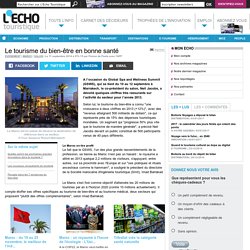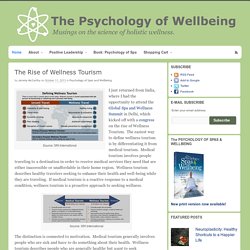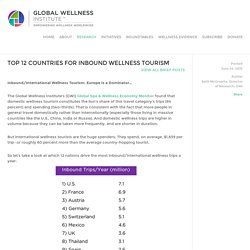

Le tourisme du bien-être en bonne santé. A l’occasion du Global Spa and Wellness Summit (GSWS), qui se tient du 10 au 12 septembre à Marrakech, le co-président du salon, Neil Jacobs, a dévoilé quelques chiffres très rassurants sur l’activité du secteur pour l’année 2013.

Selon lui, le tourisme du bien-être a connu "une croissance à deux chiffres en 2013 (+12%)", avec des "revenus atteignant 500 milliards de dollars", ce qui représente près de 15% des dépenses touristiques mondiales. Un segment qui "progresse 50% plus vite que le tourisme de manière générale", a précisé Neil Jacobs devant un public constitué de 500 participants venus de 40 pays différents. Le Maroc en tire profit Le Maroc s'est fixé comme objectif d'atteindre les 20 millions de touristes par an à l'horizon 2020 (contre 10 millions actuellement). Il compte étoffer ses offres spécifiques au tourisme de bien-être et au tourisme médical, deux secteurs qui proposent "plutôt des offres complémentaires", selon Imad Barrakad. 10 destinations incontournables pour des vacances bien-être.
Wellness Tourism Cornelia Voigt. 703d wellnessunmarchc3a9enfortecroissance 20142. The Rise of Wellness Tourism. Source: SRI International I just returned from India, where I had the opportunity to attend the Global Spa and Wellness Summit in Delhi, which kicked off with a congress on the rise of Wellness Tourism.

The easiest way to define wellness tourism is by differentiating it from medical tourism. Medical tourism involves people traveling to a destination in order to receive medical services they need that are either inaccessible or unaffordable in their home region. Wellness tourism describes healthy travelers seeking to enhance their health and well-being while they are traveling. If medical tourism is a reactive response to a medical condition, wellness tourism is a proactive approach to seeking wellness. The distinction is connected to motivation. But at 14% of expenditures, $61B for the “primary purpose wellness travelers,” or those who are travelling for the express purpose of pursuing wellness activities, still represents a big number. By Jeremy McCarthy.
Wellness tourism economy exec sum final 10022013. The Week in Stats: Business, Wellness Travel Up. Topping the news this week in travel industry stats and research were some positive signs for the business and wellness travel sectors.

Here's a quick look at what you need to know. Business Travel to Rise 3.1 Percent in 2015 U.S. business travel volume is expected to increase over the next two years, as the U.S. economy moves into higher gear, according to the new GBTA BTI Outlook – United States 2015 Q1 from the Global Business Travel Association (GBTA). Meanwhile, lower oil prices are expected to allow more modest pricing growth in air travel, ground transportation and rental cars in 2015. Overall, U.S. business travel spending is expected to advance 3.1 percent to $295.7 billion in 2015, a lower figure than last quarter's forecast due to lower than expected prices on travel goods and services.
Read more After Disasters, Wellness Tourism Recovers 170 Percent More Read more Hotel Rooms Up 7.6 Percent in the Middle East Read more 83 Percent of Travelers Outside the U.S. Top 12 Countries for Inbound Wellness Tourism — Global Wellness Institute. Inbound/International Wellness Tourism: Europe Is a Dominator… The Global Wellness Institute’s (GWI) Global Spa & Wellness Economy Monitor found that domestic wellness tourism constitutes the lion’s share of this travel category’s trips (84 percent) and spending (two-thirds).

That is consistent with the fact that more people in general travel domestically rather than internationally (especially those living in massive countries like the U.S., China, India or Russia). And domestic wellness trips are higher in volume because they can be taken more frequently, and are shorter in duration. But international wellness tourists are the huge spenders: They spend, on average, $1,639 per trip—or roughly 60 percent more than the average country-hopping tourist.
So let’s take a look at which 12 nations drive the most inbound/international wellness trips a year: Mexico is the clear inbound wellness tourism powerhouse of the Latin American world and “wellness-rich” Thailand dominates in Asia.